Mongolia
 From Rationalwiki
From Rationalwiki _-_MNG_-_UNOCHA.svg.png)
“”I’d rather suffer with my own rule than frolic away blissfully under someone else’s rule.
|
| —Mongolian proverb.[1] |
Mongolia is a landlocked and sparsely-populated country wedged between Russia (eastern Siberia) and China. The harsh landscape features a flat steppe in the north and the inhospitable Gobi Desert to the south. As a result, hundreds of thousands of Mongolians still live as horse-mounted nomads who drive their livestock and live off the land even in modern times.[2] Other Mongolians live in cities: Ulaanbaatar, the capital and largest city, hosts about 45% of the country's population.[3] 53% of the Mongolian people self-define as Buddhists, but Islam remains a significant minority (3%) religion.[4]
Mongolia's nomadic culture goes back to the very beginning of its history. In ancient times, Mongolia saw various nomadic empires sweep in to do battle with and conquer each other. Among them were peoples like the Xiongnu and the Xianbei, and the Turkic Khaganate. Raiders from the Mongol steppe became a constant scourge in the eyes of Imperial China, which invested great effort and funding into the Great Wall and into warriors to guard the northern frontier. In 1206 Genghis Khan founded the great Mongol Empire by uniting the Mongolian tribes. He conquered his way across the map and became the terror of much of Eurasia. Genghis Khan's grandson Kublai Khan concentrated on China, conquering it and founding (1271) the Yuan dynasty. The old problems with Mongol nomadic culture came back to haunt the empire, though, as Genghis Khan's descendants clashed with each other for land and partitioned the empire (1259 onwards). Disunited, many Mongols retreated back to Mongolia and resumed their pattern of infighting. This lifestyle prevented them from preventing their own conquest at the hands of the Qing dynasty in the late-17th century.
After the Qing collapsed in the revolution of 1911, Mongolia regained its independence (1911-1912) as a separate state. Full independence proved short-lived, though, because nearby Russia also exploded into revolution (1917), and unrest and ideology spilled across the borders into Mongolia. Amid the violence, the Soviet Union rose in Russia (1922), and Soviet-oriented forces installed a friendly communist puppet regime in Mongolia (1921/1924). Mongolia remained a People's Republic until the end of the Cold War when anti-communist protests forced Mongolia to peacefully transition (1990-1992) to multi-party democracy and adopt a market economy.
Today, Mongolia focuses on maintaining close ties with its two powerful neighbors, on which it relies for almost all of its imports.
Historical overview[edit]
.jpg)
The Xiongnu[edit]
Archaeological evidence indicates human inhabitation of Mongolia since the early Stone Age. By the 3rd century BCE, the early Mongol peoples had become good enough at weapons-making and warfare to start making themselves a real nuisance in the eyes of Imperial China.[5]
The first great nomad empire to form here was the Xiongnu. Their language and culture are largely unknown today, but it's likely that they highly resembled the later Mongol cultures. Mounted Xiongnu warriors were a constant headache for China during its early imperial period. The Qin and Han dynasties put a lot of effort into building defensive fortifications like the Great Wall to prevent their raids, though the extant portions of the Qin "Great Wall" reveal they were basically mud and straw; the popular image of the Great Wall is from the late Ming Dynasty, around 1,700 years later.[6] Although Chinese armies were generally stronger than them, Xiongnu cavalry-based armies were far more maneuverable and were thus able to evade or flank their slower Chinese counterparts.[7]
.jpg)
Of course, these events have gained a new relevance today, with Donald Trump comparing his proposed "Great Wall of America" to China's version.[8] That is dangerously stupid. Not only did the Great Wall of China take centuries to build at a great human cost, but it was also largely ineffective at its primary purpose. The Great Wall indeed halted minor incursions, but more determined armies could simply find a place where the wall had fallen into disrepair or even ended.[9] The simple fact is that the Great Wall was too big to effectively maintain or guard without the enormous investments that generals from all iterations of it warned were necessary; invariably, just like today's border patrol, no emperor properly funded upkeep, and it never ended well for the dynasty.

As a result, the Xiongnu didn't find it too difficult to attack China whenever they felt like it. In 200 BCE, they mounted an expedition across the wall that ended up with them in control of large portions of northern China.[6] As the Han dynasty weakened (see the Imperial China article for why that happened), the Xiongnu attacked them incessantly.
The Xianbei and Rouran[edit]
The pressure of constant warfare caused the Xiongnu tribal alliance to disintegrate, although it was soon followed by the Xianbei in 93 CE.[10] The Xianbei were notable for introducing a novel idea into the old ways of mounted warfare: horse archery.[11] Also, instead of promoting commanders based on heredity, the Xianbei were more meritocratic.
With their military innovations, the Xianbei managed to occupy a large chunk of northern China and become a real problem during China's North and South Period. Some Xianbei even declared their own wannabe dynasty, the Wei, which undertook a cultural assimilation program to conform their population with other Chinese states.[12]
After the Xianbei collapsed into typical nomadic infighting, the Rouran state succeeded them. The Rouran were noted for being the first Mongol state to use the term "khan", and they're also noted for the controversy over whether they're the ancestors of nomads who made their way to Europe like the Pannonians.[13]
The Turks[edit]

From an obscure background, the Göktürks, or "Blue Turks", arose in Central Asia and conquered Mongolia to form the Turkic Khaganate. The Turks are currently theorized to be the ancestors of the Huns, who would play a major role in taking down the Western Roman Empire.[14] Whatever their exact origin or relatives, the Göktürks were the first culture group to refer to themselves as "Turks".[14] Their descendants who moved further west would become the Turkic nomads of places like Kazakhstan, who would take over vast portions of the Middle East. The eastern Turks remained in Mongolia, where they followed the old traditions of raiding China for wealth and prestige.[15]
The heyday of the eastern Turks ended abruptly when the newly-formed Tang dynasty rolled in with a shitload of soldiers in the hopes of ending Turkish raids for good. The Tang dynasty simply annexed the Turks, bringing Xinjiang and most of Mongolia into the Chinese Empire, not in the mood to mess around.[16] Like any good imperialist power, the Tang dynasty encouraged infighting between the various Turkic tribes under their rule like the Uyghurs, the Karluks, and the Kyrgyz. That ended up backfiring, as the Turkic tribes were the cornerstone of the Tang dynasty's defensive abilities to the east, weakening them weakened the empire as a whole.[16]
Tribal consolidation[edit]
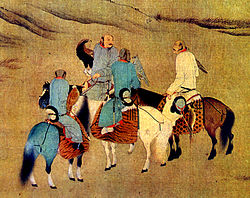
The 900s CE proved to be the beginning of a long period of tribal unification across Mongolia and Central Asia. This period began when the Khitan peoples swept through Mongolia and northern China, conquering themselves a new empire that they called the Liao dynasty.[17] Along with being the first state to control all of Manchuria, the Liao dynasty integrated Mongolia and much of northern China into its domains.[18]
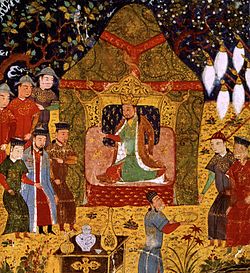
Unlike previous Mongolian empires, the Liao dynasty began settling many of its people into cities and villages while emphasizing that the various Mongol peoples had close racial and cultural links.[17] The Liao would later fall to a rebellion of the Jurchen tribal nomads, who inhabited Manchuria at the time. The Jurchens formed the Jin dynasty in 1115 CE, which weakened itself and the Chinese Song dynasty by launching a century-long war of conquest.[19]
With the Jin focusing on affairs in northern China, a power vacuum emerged in Mongolia. This opening would be filled by the Borjigin clan, who promptly decided that the Jin had become too culturally Chinese and were thus a nice target for raiding. Temujin Borjigin, with a skilled mind for Mongol warfare, soon emerged as the unquestioned chief of a rapidly growing group of Mongol tribes.[20]
In 1206, the various Mongol tribes assembled a kurultai, or tribal council, to confirm Temujin Borjigin as their official leader. He took the title Chinggis, or "Supreme", Khan.[20] That title would be Romanized as "Genghis", since Western sources learned of the title from Arabic, which lacks the ch sound. Genghis Khan's leadership style proved to be a significant departure from those who had come before him, as he was a hands-on and autocratic ruler. In contrast, his predecessors generally didn't interfere too much with their subordinates or the old ways of doing things. Temujin ordered records put down indicating that he had divine ancestry, and then he began a policy of taking direct control over clan successions.[20] He then organized a census to make recruiting soldiers easier. This unprecedented combination of an organized state with Mongol-style warfare genius proved to be a potent recipe for conquest.
Mongol Empire[edit]
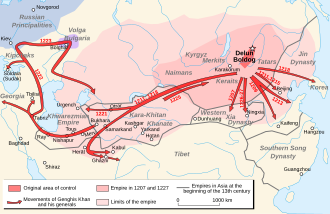
Genghis Khan's conquests[edit]
“”I am the punishment of God. If you had not committed great sins, God would not have sent a punishment like me on you.
|
| —Genghis Khan during the sack of Bukhara.[21] |
Genghis Khan rapidly seized control of the Jin territory in northern China before embarking for Central Asia in 1219. The siege of Kaifeng, the capital of the Jin dynasty, featured heavy use of gunpowder and artillery.[22]
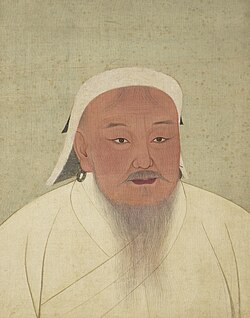
The Central Asian campaign would be his most brutal: a local Kwarezmian ruler made the mistake of killing some of his envoys, so he responded by razing some of the old world's largest and most important cities. Among them was Bukhara, a flourishing Silk Road city that was one of the Persian world's intellectual centers.[23] Samarkand was even bigger, and its conquest saw Temujin have prisoners used as meat shields during the assault.[23] Some of the city's soldiers fled into a mosque hoping for protection from God, but the Mongols simply set the building on fire to burn everyone inside alive.[21] God's protection never materialized. Merv, another great city in the region, saw 700,000 of its residents murdered during the Mongol conquest in 1221.[24] Kingdoms that surrendered were made to pay tribute and provide slaves, while those that resisted faced the threat of destruction.
The Mongols also smashed through Afghanistan, though the Afghans predictably rose up in rebellion soon after. Within Temujin's lifetime, the Mongols reached Eastern Europe, sending expeditions into Ukraine to explore the strengths and weaknesses of the Slavs.[21] This would pave the way for further warfare.
Having conquered an empire, Temujin decided to focus on what would happen after he died. Temujin was well aware that the greatest weaknesses of the old tribal empires came when succession disputes caused the empires to be partitioned and then torn apart in civil war. Therefore, he clarified an orderly succession plan to pass control of his empire entirely to his son Ogedei. Temujin died in 1227, and by his orders, his tomb's location was kept secret while any traces above ground were destroyed.[25]
Successors and more conquests[edit]
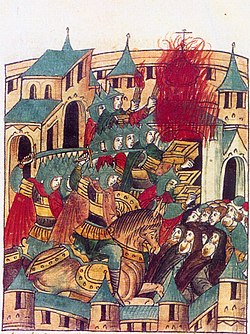
Per Temujin's wishes, the tribal council of 1228 selected Ogedei as the new Genghis Khan. Ogedei was considered extremely charismatic and personable, but he infamously built a vast harem and allegedly raped hundreds of girls.[26]
Under Ogedei Khan, the Mongols began their invasion of Eastern Europe. The Slavic world's cultural and political epicenter, Kyiv, fell easily to the Mongols.[23] That opened up the rural countryside of Eastern Europe to plunder and destruction. Meanwhile, relations between the Mongol Empire and the Song dynasty in China soured significantly. They had initially coexisted rather nicely due to their hostility against the Jurchen Jin state. However, the Jin's downfall saw the two powers begin to violently dispute where their new border should lie.[27]
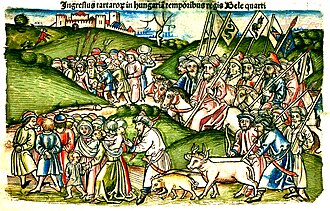
This resulted in a mutual declaration of war in 1234, pitting the still sparsely-populated Mongol state against the most populated region on Earth. The war went on for decades and continued under Ogedei's successors. The Mongols could flank and destroy the larger and better-equipped Chinese armies using their superior mobility and tactics.[28] The Song dynasty's divisive internal politics also meant that the Mongols were aided by Chinese generals and military experts disillusioned with the emperor.
The Mongol invasions of Europe also rapidly escalated in scope, eventually reaching the Chinese campaign in significance. The Mongols committed about 600,000 men to mess up Eastern Europe with plundering and death.[29] The Mongols proved unstoppable, and their raiding parties reached Italy and Austria. The Mongols then invaded Hungary, causing enormous devastation and winning a significant military victory.[30]
Hungary would be spared, though, by the sudden death of Ogedei in late 1241. Since the tribal tradition mandated that the Genghis Khan's heirs assemble in Mongolia to choose a successor, most of the Mongol Empire's best generals had to put aside their war in Europe and withdraw.[29]
Amid a disputed selection, Mengke became the new Genghis Khan in 1251. He was an even more energetic conqueror than Ogedei had been, and he was determined to close the war in China. He sent his brother Hulagu off to Europe to continue the wars there, but his main focus was on taking personal command of the conquest of China.[31] China had a huge population and many fortified cities, but it fell to Mengke by 1259. His sudden death of dysentery (hello, Oregon Trail) left the Mongol Empire in stasis again.
Civil wars and partition[edit]
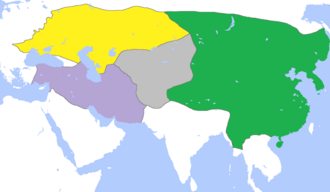
Although the Mongol Empire had organized itself well, the old problems with tribal nomadism came home to roost again after Mengke's death. Two hopefuls for the title of Genghis Khan, Kublai and Arik-Buka, resulted in a brief civil war between the two that ended with Kublai's victory.[32] Although Kublai became Genghis Khan, other descendants of Temujin followed his example and warred with each other for land inside the Mongol Empire. These wars lasted decades and completely destroyed the authority of the Genghis Khan over the Mongol Empire as a whole.[33]
The Mongol Empire fractured due to the irreconcilable power struggles between the various heirs of Temujin. Kublai Khan took the best part, becoming the founder and first emperor of the Yuan dynasty in China. Meanwhile, the western and European fringes of the empire became the Golden Horde under Batu Khan, the Persian territories became the Ilkhanate under Hulagu Khan, and Central Asia became the Chagatai Khanate under Chagatai Khan.[34]
Constant political and military struggles between the Mongol successor states and other regional powers caused the destruction of all of the remnants of Genghis Khan's conquests. Due to their comparably tiny numbers compared to their conquered subjects, each Mongol state adopted the culture of the area in which it was located, causing the dissolution of Mongol unity.[35] The Mongol lifestyle had made them great conquerors, but they were ill-suited to the demands of ruling such a massive empire.
Return to nomadism[edit]

The era of Mongol imperialism decisively ended when the Yuan dynasty collapsed. Its end came in 1351 from within, when vast numbers of Chinese peasants revolted due to prolonged mistreatment and economic decline.[36] After the Yuan fell, the Mongols who lived there fled back into their traditional heartland. About 60,000 people returned to Mongolia, returning to the old ways of nomadism and internal conflict.[37]
The Mongols split into two main groups, based mainly on which of their leaders descended from Temujin. The non-Genghisids, as they're called, became the Oirat Horde.[38] The Oirats warred against the Mongols for decades, weakening both factions. Meanwhile, the rising Ming dynasty in China had no reason to feel any sympathy for the Mongols and thus launched a series of invasions meant to destroy Mongol power.[39]
Although the Mongols often did quite well for themselves, even on one occasion capturing the Ming emperor himself, it was clear that the Mongol Empire could never be restored.[37] Mongol rule decentralized even further, effectively ending any semblance of a Mongol state. That was a bad time for this to happen, as the Mongols soon found themselves sandwiched between two rising powers. From the west, Russia colonized eastward, and their early modern techniques and technologies of warfare vastly outperformed the old Mongol cavalry armies.[40] To the east, the Jurchen tribes consolidated into their own empire and became the Manchus of Manchuria. The Manchus used their great numbers and skill at warfare to overrun the decaying Ming dynasty and found their own Chinese regime in 1644: the Qing dynasty.
Under the Qing[edit]
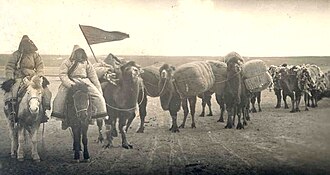
The Qing dynasty sent imperialist expeditions to Tibet and Mongolia, not content with conquering China itself. With artillery and firearms on their side, the Qing proved effective even against the Mongol cavalry, and one by one, the various Mongol khans had no choice but to swear their loyalty to the new dragon throne.[41] The conquerors had become the conquered.
.jpg)
The Manchus imposed their very rigid idea of a class structure onto the Mongols, effectively turning them into a feudal state. The Mongols were split into "banners", and membership in those banners was hereditary. The Qing kept the Mongols disunited and easy to control through these methods.[41] Mongol banners had their own borders, and Mongols were forbidden on pain of severe punishment from crossing those borders.[43] This interfered with religious pilgrimages, so the Qing then mandated that pilgrims had to apply for passports.
The Qing then embarked on a nakedly colonial policy of settling Han Chinese into the region now called Inner Mongolia;[44] that province has remained firmly in Chinese hands ever since.
Economically, the Qing imposed yet another form of control over the Mongols by keeping their families in harsh debt and subjected to high taxes just for the right to live in their own country.[41] Resentment towards this policy was a major impetus for Mongolian nationalism. Rioting, Mongol troop mutinies, and other anti-Chinese incidents occurred with increasing regularity as the years went on. Mongol loyalty towards the Qing was utterly broken when the 1911 revolution broke out.[41]
Brief independence[edit]
As the Qing dynasty blew up in revolution, Mongolia's noble classes unilaterally decided to declare the country's independence as a monarchy. Seeing an opportunity to net itself a nice little protectorate, the Russian Empire sent monetary aid to Mongolia and placed the country under its diplomatic protection in 1912.[45] With support from Russia's massive army, Mongolia effectively became untouchable to China. Not that China was super interested in retaking Mongolia since the revolution that began in 1911 had spiraled into a quasi-civil war between various governments and armed warlords. Russian cash helped finance the creation of Mongolian infrastructure, schools, and a military.[46]
After gaining its independence, Mongolia's nobles restructured government and society to benefit themselves. Mongolia became a Buddhist theocracy led by an unquestionable Bogd Khan, who established a rigid caste system that placed nobles and holy men at the top.[47] With state affairs directed by detached Buddhist monks, the Mongolian government unsurprisingly collapsed into an inefficient mess. Worst of all was the Ministry of Internal Affairs. This totalitarian institution that patrolled Mongolia's populated areas to ensure that the general population behaved with an appropriate amount of deference towards nobles and monks.[47] Their role was similar to that of the Taliban's religious police.
People's Republic[edit]
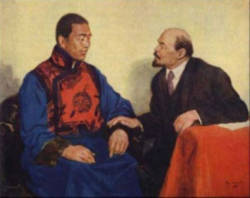
Revolutionary restructuring[edit]
In 1917, Mongolia's theocratic period was cut short when Russia went up into revolution just like the Chinese had done. Mongolia's position suddenly became very precarious, with both of its neighbors in flames. The country faced invasions, first from Chinese warlords and then by rogue Russian general Roman von Ungern-Sternberg.[48] Mongolian political groups banded together against the various invading forces on the advice of the Red Russians, forming the Mongolian People's Party.[49] Under Russian communist influence and their aid, the Party overthrew the Bogd Khan government. Soviet soldiers poured into Mongolia and effectively placed the country under occupation.
At this time, the Mongolian People's Party had not yet embraced complete Soviet-style communism. In 1922, though, the Soviets encouraged their supporters to purge and execute anti-Soviet elements within the party.[50] Anyone who hoped to reduce Soviet influence over Mongolia was dead or imprisoned. Mongolia adopted a Soviet-style constitution in 1924 while the party renamed itself the Mongolian People's Revolutionary Party.[50] Mongolia had become a Soviet satellite state.
Under Soviet guidance, Mongolia abolished feudalism, kicked the nobles onto the streets, and built a state-run economy.[51] However, Mongolia's very nature seemed to defy communism. It had almost no industry or agriculture, most of its population was illiterate and nomadic, and the party had little grassroots support.
Stalinist control[edit]
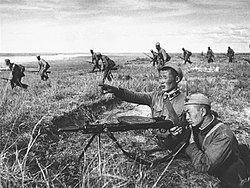
Soviet brutality in Mongolia intensified during the reign of Joseph Stalin. Stalin hoped to end the gradual approach and instead completely restructure Mongolian society; Stalin ordered purges of anyone who disagreed with him.[52] Stalin's supporters then launched purges of the religious establishment, confiscating their property and redistributing land. Thousands of Buddhist monks were executed.
Despite transforming Mongolia into ripe ground for industrialization, Stalin proceeded to intentionally stunt Mongolian development. With Japan gaining power nearby, Stalin didn't want to make Mongolia an attractive target for conquest by filling it with factories.[53] Instead, the Soviets focused on mining to hustle off Mongolia's raw materials to bolster Soviet industry because the Soviets were just as imperialist as any other empire.
Despite Soviet attempts to avoid antagonizing the Japanese, bloody border conflicts between the two powers erupted between the two powers on the border between Mongolia and the Japanese puppet government in Manchuria.[54] The exploitation of Mongolia intensified during World War II, as the Soviets extracted even more natural resources from the country and received "volunteer" armies.[55] Mongolian soldiers also participated in the invasion of Manchuria in 1945, when the Soviet Union finally declared full war on Japan in the last days of the war.
Development[edit]
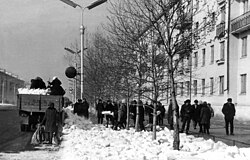
Mongolia remained a staunch Soviet ally throughout the Cold War, even moving in 1946 to adopt the Cyrillic alphabet.[56] After Stalin's death, Mongolia and its Soviet overseers shifted their focus into finally building Mongolia into a modern state. With Mao Zedong winning victories in the Chinese Civil War and defending Chinese communism during the Korean War, the Soviets and Chinese cooperated to build up Mongolia.
Eventually, the Chinese and the Soviets had their ugly divorce, and the Soviets won Mongolia in the custody battle.[57] As a Soviet ally, Mongolia became the front line between the Soviets and China. Mongolia's leader Yumjaagiin Tsedenbal even submitted repeated requests for admission into the Soviet Union, although the Russians were never interested.[58]
Democratization and modern Mongolia[edit]

“”Ulaanbaatar remains heavily dependent on the mining sector for its economic fortunes, which have been battered over the past three years due to the sinking price of coal as global supply outpaced demand.
|
| —Jonathan Berkshire Miller, director of the Council on International Policy, 2016.[59] |
Like other Soviet-aligned states, Mongolia benefited from Mikhail Gorbachev's liberalization reforms. Mongolian nationalism was no longer stigmatized, and democracy advocacy was tolerated.[60] This escalated into a general protest movement in 1989, as the Eastern Bloc states began to fall to their own domestic unrest. With the Mongolian authorities unwilling to crack down violently, the legislature and Politburo resigned and paved the way for elections in 1990. The election proved divisive, though, as the Mongolian People's Revolutionary Party remained dominant since opposition parties were new and didn't have the resources to fight this.[61] The failed 1991 coup in the Soviet Union spiked tensions again. The government appeased the people by barring members of the judiciary and military from being a member of the old communist party.[62]
Since then, Buddhism has seen a resurgence in popular support, and the purges and crimes of the Soviet Union are being investigated. Mongolia's transition to a market economy was typically troublesome, and the country spent the 1990s dealing with food shortages and high inflation.[63] Mongolia also supported the United States' opening of hostilities in the 2003 Iraq War, sending troops to guard oil pipelines.[64] Mongolians in the Middle East again? History screams.
Gallery[edit]
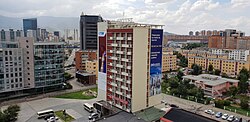
Skyline of Ulaanbaatar.
Mongolian meat and innards stew.
Yurts on the Mongol steppe.

Mongol women in festival dress.
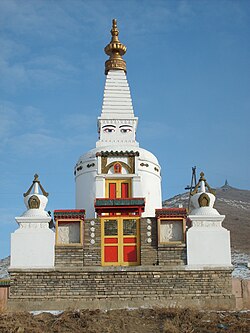
Buddhist stupa in Mongolia's capital.
See also[edit]
- Kazakhstan
- Kyrgyzstan
References[edit]
- ↑ 10 Proverbs That Will Help You Understand the Mongolian Mindset. Local Friends in Mongolia. Blogspot.
- ↑ 21st Century Nomads: Life In The Mongolian Steppe. All That's Interesting.
- ↑ Mongolia Population 2020 (Live). World Population Review.
- ↑ See the Wikipedia article on Religion in Mongolia.
- ↑ Mongolia: Origins of the Mongols. Country Studies.
- ↑ 6.0 6.1 Mongolia: Xiongnu and Yuezhi. Country Studies.
- ↑ Xiongnu. Britannica.
- ↑ Trump says his Mexico wall will be like the Great Wall of China. Here’s why that comparison is terrible. South China Morning Post.
- ↑ Donald Trump Loves the Great Wall of China. Too Bad It Was a Complete Disaster. Mother Jones.
- ↑ Wyatt, James C. Y. (2004). China: Dawn of a Golden Age, 200-750 AD. Metropolitan Museum of Art. ISBN 978-1-58839-126-1. p. 8
- ↑ Mongolia: Donghu, Toba, and Ruruan. Country Studies.
- ↑ The Southern and Northern Dynasties. China Highlights.
- ↑ See the Wikipedia article on Rouran Khaganate.
- ↑ 14.0 14.1 Göktürks (Blue Turks). History Files.
- ↑ Mongolia: Rise of the Türk. Country Studies.
- ↑ 16.0 16.1 Mongolia: Influence of Tang China. Country Studies.
- ↑ 17.0 17.1 Mongolia: Kitan and Jurchen. Country Studies.
- ↑ See the Wikipedia article on Liao dynasty.
- ↑ See the Wikipedia article on Jin dynasty (1115–1234).
- ↑ 20.0 20.1 20.2 Mongolia: Rise of Chinggis Khan. Country Studies.
- ↑ 21.0 21.1 21.2 Genghis Khan's Conquests. Facts and Details.
- ↑ See the Wikipedia article on Mongol siege of Kaifeng.
- ↑ 23.0 23.1 23.2 10 Major Cities Sacked by the Mongols. Real Clear History.
- ↑ Lost cities #5: how the magnificent city of Merv was razed – and never recovered. The Guardian.
- ↑ Why Genghis Khan's Tomb Can't Be Found. BBC Travel.
- ↑ Weatherford, Jack. (2011). The secret history of the Mongol queens : how the daughters of Genghis Khan rescued his empire. pp. 89–90. ISBN 9780307407160. OCLC 915759962.
- ↑ Ogedei and Continuing Conquests. Country Studies.
- ↑ Invasion of the Song state. Britannica.
- ↑ 29.0 29.1 Subetei and the European Expedition. Britannica.
- ↑ See the Wikipedia article on First Mongol invasion of Hungary.
- ↑ Mengke and the War in China. Country Studies.
- ↑ See the Wikipedia article on Toluid Civil War.
- ↑ Allsen, Thomas (2001). Culture and Conquest in Mongol Eurasia. Cambridge University Press. ISBN 978-0-521-80335-9. p. 24
- ↑ See the Wikipedia article on Division of the Mongol Empire.
- ↑ The Mongol Decline. Country Studies.
- ↑ The Red Turban Rebellion in China (1351-1368) ThoughtCo.
- ↑ 37.0 37.1 Mongolia: Return to Nomadic Patterns. Country Studies.
- ↑ See the Wikipedia article on Oirats.
- ↑ See the Wikipedia article on Yongle Emperor's campaigns against the Mongols.
- ↑ Mongolia: Caught Between the Russians and the Manchus. Country Studies.
- ↑ 41.0 41.1 41.2 41.3 Mongolia: End of Independence. Country Studies.
- ↑ A Mongolian woman reaches out from the porthole of a crate in which she is imprisoned, 1913. Rare Historical Photos.
- ↑ Charleux, Isabelle (2015). Nomads on Pilgrimage: Mongols on Wutaishan (China), 1800-1940. BRILL. p. 15. ISBN 978-9004297784.
- ↑ Reardon-Anderson, James (Oct 2000). "Land Use and Society in Manchuria and Inner Mongolia during the Qing Dynasty". Environmental History. 5 (4): 506. doi:10.2307/3985584. JSTOR 3985584.
- ↑ 5. China/Mongolia (1911-1946). University of Central Arkansas.]]
- ↑ Mongolia 1911-1920. Google Arts and Culture.
- ↑ 47.0 47.1 See the Wikipedia article on Bogd Khanate of Mongolia.
- ↑ See the Wikipedia article on Roman von Ungern-Sternberg.
- ↑ Mongolia: Period of Autonomy, 1911-21. Country Studies.
- ↑ 50.0 50.1 Mongolia: Revolutionary Transformation, 1921-24. Country Studies.
- ↑ Mongolian People's Republic, 1925- 28. Country Studies.
- ↑ Mongolia: Purges of the Opposition, 1928-32. Country Studies.
- ↑ Mongolia: Economic Gradualism and National Defense, 1932-45. Country Studies.
- ↑ See the Wikipedia article on Battles of Khalkhin Gol.
- ↑ See the Wikipedia article on Mongolia in World War II.
- ↑ Mongolia: Peacetime Development, 1946-52. Country Studies.
- ↑ Socialist Construction under Tsedenbal, 1952-84. Country Studies.
- ↑ See the Wikipedia article on Yumjaagiin Tsedenbal.
- ↑ Mongolia. Wikiquote.
- ↑ Reform and the birth of democracy. Britannica.
- ↑ See the Wikipedia article on 1990 Mongolian legislative election.
- ↑ Mongolia: Constitutional change. Britannica.
- ↑ Rossabi, Morris (2005). Modern Mongolia: From Khans to Commissars to Capitalists. Berkeley: University of California Press. pp. 57–58, 143–144. ISBN 978-0520244191.
- ↑ Mongolians Return to Baghdad, This Time as Peacekeepers. New York Times.
Categories: [Asian countries] [Imperialism]
↧ Download as ZWI file | Last modified: 11/08/2025 02:55:28 | 88 views
☰ Source: https://rationalwiki.org/wiki/Mongolia | License: CC BY-SA 3.0
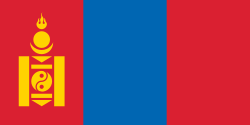
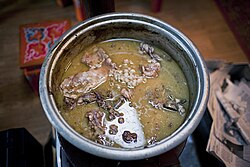

 KSF
KSF